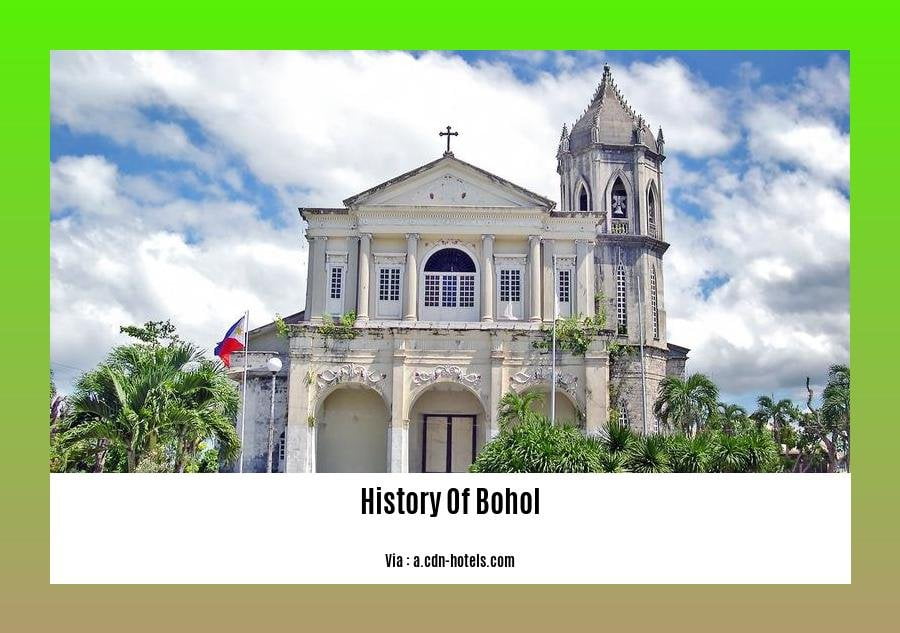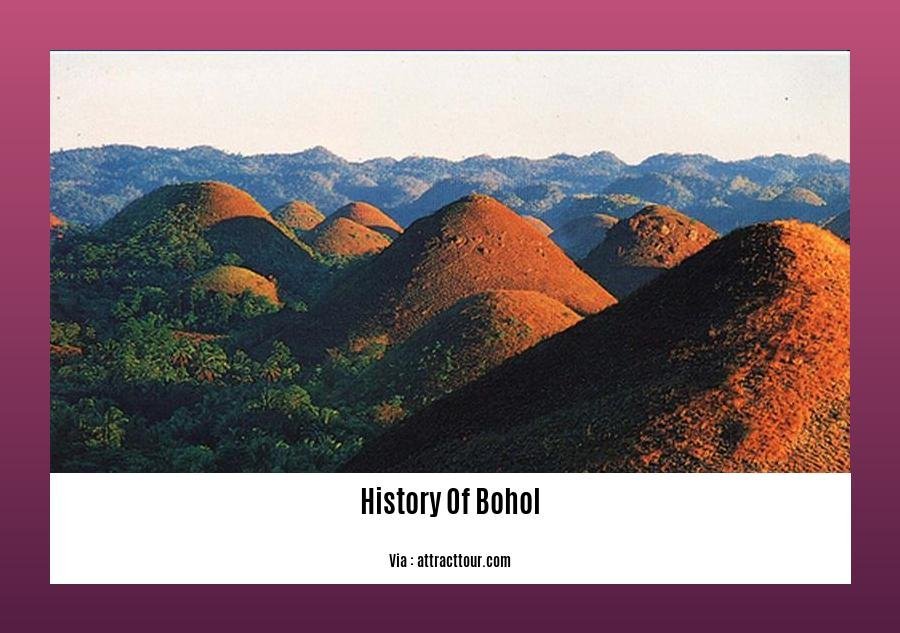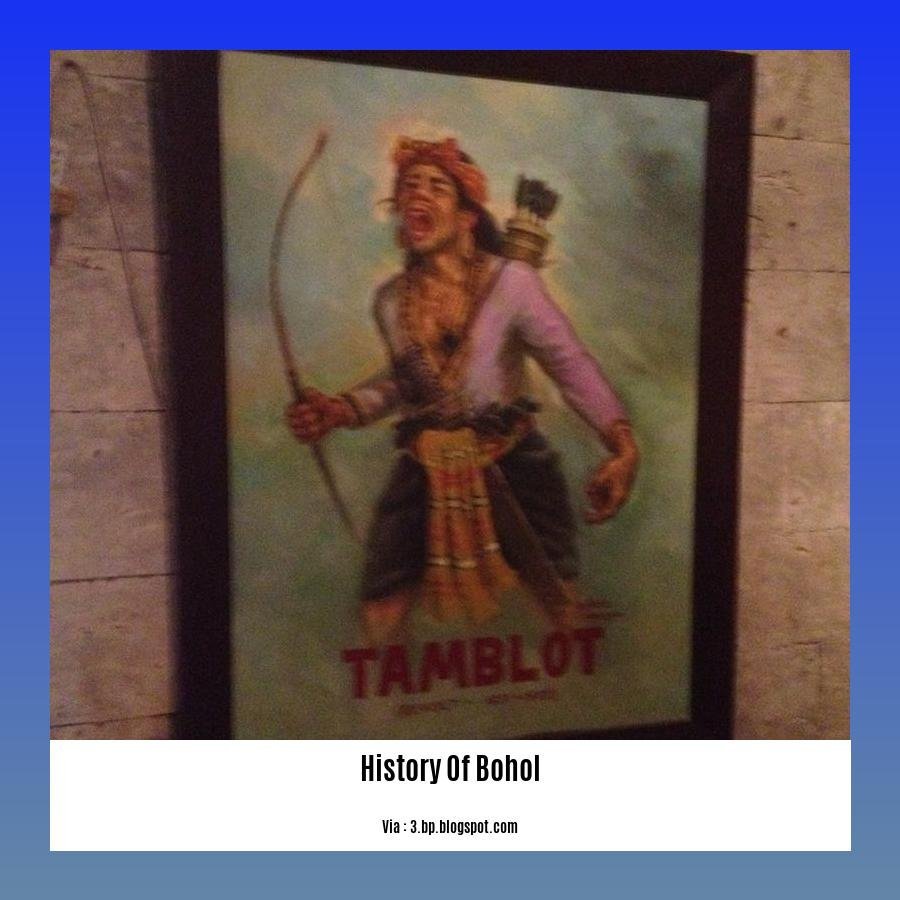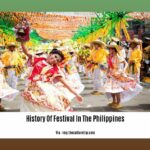Welcome to Bohol’s historical paradise. Come along as we travel across time and untangles the rich tapestry of Bohol’s legendary past. Let’s discover the fascinating stories that have molded the special character of this magical island, solve the riddles of centuries-old customs, and see historic sites.
Key Takeaways:
- Bohol, the 10th largest Philippine island, is nestled in the Visayas Region.
- Pygmies from the Malay Peninsula were the first settlers in the Visayas, including Bohol, around 15,000 BC.
- Seafaring Indo-Malays migrated to Bohol approximately 3000 BC.
- Bohol had substantial trading relations with the Chinese for an extended period.
- Bohol was a Jesuit mission founded in 1595 and later became a distinct province in 1854.
- Two major uprisings occurred during Spanish rule: the Tamblot Revolt in 1621 and the Dagohoy Rebellion from 1744 to 1829.
- American forces seized Bohol in 1900.
- Bohol’s municipality of Talibon was the birthplace of Carlos Polistico Garcia, the Philippines’ fourth President.
The History of Bohol: A Tapestry of Time

Tenth in size among the Philippine islands, Bohol possesses a rich and varied past that has molded its own culture and character. From the first immigrants’ arrival till now, Bohol has seen a great range of events that have permanently changed its terrain and population.
The earliest occupants
Early known occupants of Bohol were Malay Peninsula pygmies arriving about 15,000 BC. These hunter-gatherers left remains of their existence in the shape of stone tools and bits of pottery as they formed villages all throughout the island.
A fresh group of immigrants came in Bohol about 3000 BC: seafaring Indo-Malays. Advanced farming methods and metalworking skills provided by these immigrants changed the island’s economy and society.
Pre-Colonial Age
Pre-colonial history of Bohol is distinguished by active trading with Chinese neighbors. Strategic location of the island made it a hub for trade of products; it soon developed into a center of business and cultural interchange.
Phase of Spanish Colonialism
Officially included into the Spanish Empire in 1595, Bohol became a Jesuit mission. Christianity was brought by the Spanish and soon adopted among the people of the island.
Two major upheavals also occurred during the Spanish colonial era: the Dagohoy Rebellion spanning 1744 to 1829 and the Tamblot Revolt in 1621. The repressive practices of the Spanish colonial authority and the quest of freedom among the Boholanos set off these upheavals.
American Colonization Period
The United States won the Spanish-American War that started in 1898. The Philippines—including Bohol—was therefore turned over to the United States.
Bohol changed in several ways throughout the American colonial era. New hospitals and schools were constructed while the island’s infrastructure underwent enhancement. Nonetheless, the Boholanos, who kept on their struggle for independence, also opposed the American colonial administration.
Period Following Colonization
The Philippines at last acquired her freedom from the United States in 1946. Since it became a province of the recently independent republic, Bohol has been rather important in the history of the nation.
Carlos Polistico Garcia, the fourth President of the Republic of the Philippines from 1957 to 1961, is among the most well-known personalities from post-colonial history of Bohol. Born in Talibon, Bohol, Garcia is generally seen as one of the most successful presidents of the nation.
- Immerse yourself in the rich tapestry of Andul Rajbari’s history, a regal fortress that has stood the test of time. Dive into The History of Andul Rajbari to unveil its captivating tales.
- Through the ages, Bangladesh and World Civilization have been intricately intertwined. Explore their profound connection by delving into The History of Bangladesh and World Civilization.
The Seeds of Revolution: Bohol’s Role in the Philippine Struggle for Independence

Key Learnings: * Bohol, known as the Dagohoy Rebellion, was the scene of one of the most protracted and influential upheavals in Philippine history. From 1744 to 1829, Francisco Dagohoy, a dynamic leader, guided the Boholanos in a strong opposition against the Spanish rule for 85 years. Grivals over land conflicts, high taxes, and abuses by Spanish officials set out the Dagohoy Rebellion. The uprising was evidence of the Boholanos’ relentless yearning for freedom and autonomy, therefore transforming the Philippine independence campaign.
Bohol, a lush island in the middle of the Philippines, where the Dagohoy Rebellion—a magnificent act of defiance—occurred—had the seeds of revolution sown. The longest-running insurrection in Philippine history, spanning eight and a half decades from 1744 to 1829, this one is evidence of the Boholanos’ relentless spirit and staunch opposition to colonial control.
The spark burns:
Driven by repressive land laws, outrageous taxes imposed by the Spanish government, and local authorities’ misuse of authority, unhappiness simmered among the Boholanos among the rich surroundings of Bohol. Francisco Dagohoy, sometimes known as “Francisco Sendrijas,” arose as the protector of the downtrodden in this milieu of injustice.
A charismatic leader surfaces:
Visionary with a great passion for his country, Dagohoy united the Boholanos behind the flag of freedom to fan the flames of revolt. Skilled in diplomacy as well as military, he brought the Boholanos together to turn their complaints into a potent weapon of resistance.
The struggle unfolds:
The Dagohoy Rebellion broke out in relentless force in 1744, its echoes echoing over the island. Armed with a strong sense of injustice and a great yearning for freedom, the Boholanos launched an unrelenting battle against the Spanish colonial forces.
An Archive of Resistance:
A monument to the resolute spirit of Bohol’s people, the Dagohoy Rebellion is a shining example of their unwavering dedication to freedom. It reminds us of the sacrifices our forebears made in their unrelenting quest of freedom; this legacy still inspires next generations.
Notes:
[1] Zaide, G. ( 2009 ) The history of the Filipino people. National Bookstore.
[2] Borja, R., 2005. Bohol: The Foundation of History San Carlos University: University
The American Occupation: A Period of Transition and Change in Bohol
Bohol was caught in the currents of change when the turn of the 20th century arrived, between the declining influence of colonial Spain and the rising tide of American might. From 1900 to 1902, this time known as the American Occupation brought turmoil, adaptation, and seeds of future progress that would define a transforming era.
Main lessons:
Beginning in 1900 and running through 1902, the American occupation of Bohol lasted two years.
To keep law and order and progressively take over army duties, the U.S. military created a constabulary, or police force.
The official shift to civil governance began on April 3, 1902, moving power from military to civilian officials.
American control provided new farming methods, educational buildings, and improvements in infrastructure.
Cultural differences and opposing interests between the U.S. government and the local community presented obstacles and resistance for the American Occupation as well.
Formulating a New Order:
The entrance of American soldiers in Bohol signaled a sea change in the history of the island. During the change period, the U.S. military aimed to be present and preserve peace and order. Established as a constabulary—that is, a police force—they progressively took over army duties in law enforcement and island monitoring. This change in military to civilian authority prepared the stage for a new age of government.
A Novel Chapter of Governance:
The change to a civil administration gathered steam as the American occupation went on. A turning point was reached on April 3, 1902 when the surviving 19th infantry units left Bohol, therefore formally transferring control to civilian authorities. This signaled the end of direct military control and the beginning of a new era of government, therefore enabling the growth of local institutions and the involvement of Boholanos in their own affairs.
Resilience and Development: Against Resistance
Along with developments in infrastructure, the American era provided schools, modern farming methods, and These changes sought to raise the living standards and economic possibilities for Bohol’s population. Still, the American rule faced difficulties and opposition as well. Sometimes problems resulted from cultural differences and competing interests between the U.S. government and the local people. Adapted to a distinct kind of government and social practices, the Boholanos had to acclimate to the new American system, which resulted in a time of compromise and bargaining.
A legacy of transformation:
Though very short, the American Occupation left traces on the history of Bohol. Future development was set in motion by American institutions, educational reforms, and infrastructural building. American rule also shaped the political scene of Bohol, hence fostering local government and the growth of Filipino nationalism.
Citation:
The American Occupation of Bohol
American Occupation of the Philippines, 1898-1913
Post-War Bohol: Navigating the Path to Progress and Development
Like the rest of the Philippines, Bohol started a path of rebuilding and development following World War II. Notwithstanding the difficulties the war’s aftermath presented, the province’s tenacity and will were clear. Let’s investigate how Bohol negotiated this road toward development:
Agriculture: Raising the Land’s Richness
The rich soil and mild temperature of Bohol made agriculture the pillar of its post-war industry. Farmers used new methods and varied their crops, therefore raising output and improving their quality of living.
Infrastructure: Creating Path for Development
Development of Bohol depended critically on the rebuilding of roads, bridges, and other infrastructure. These developments changed the province’s connection by facilitating trade, transportation, access to healthcare and education, therefore reshaping its economy.
Education: Equipping the Next Generation
With colleges and universities emerging to satisfy the rising need for knowledge and skills, education became a top concern. Boholanos welcomed learning as a way to better their life and help the province grow.
Travel: Revealing Bohol’s Natural Beauty
Particularly with its famous Chocolate Hills, Bohol’s breathtaking natural beauty drew visitors from all around. Emerging as a major economic engine, tourism highlights Bohol’s special legacy and generates employment.
Trials and Triumphs: Changing the Future of Bohol
There were difficulties in the years following conflict as well. Natural calamities, economic swings, and political ambigues tried Bohol’s fortitude. Still, the province’s relentless energy and the people’s unflinching will drove it ahead.
Key Takeaways:
- Bohol’s post-war development focused on agriculture, infrastructure, education, and tourism.
- Modernization and diversification in agriculture led to increased productivity.
- Improved infrastructure enhanced connectivity and access to essential services.
- Education empowered the next generation, contributing to Bohol’s progress.
- Tourism, driven by Bohol’s natural beauty, emerged as a significant economic driver.
- The province faced challenges but persevered with resilience and determination.
Sources:
- Bohol Historical Sites, Heritage, Events, and Attractions
- George Percival Scriven: An American in Bohol, the Philippines, 1900-1902
q
- Sept 31 Myth: Unveiling Calendar Secrets - March 18, 2025
- How Long & Till December 18, 2025: Accurate Countdown Guide - March 18, 2025
- Discover Japanese Artists: A Complete History - March 18, 2025
















